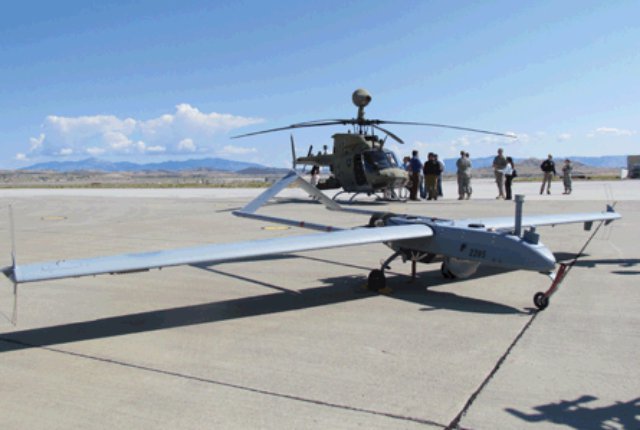The US Marine Corps will deploy AAI RQ-7 Shadows to Afghanistan armed with classified new gravity bombs in a demonstration that could pave the way for a dramatic expansion in the numbers of weaponised unmanned aircraft.
Although by far the most numerous UAS fleet, the RQ-7 has remained unarmed in the absence of precision, air-dropped weapons small enough for the aircraft to carry.
The lack of armed RQ-7s has frustrated the USMC. On a recent deployment by a single unit, the marines counted 94 “high-value targets” that escaped even though they were spotted by RQ-7s circling overhead, said Steven Reid, Vice-President of AAI’s unmanned systems division.
The unarmed RQ-7 could only hand off the targets to other weaponised platforms, such as helicopters and fighters, but none were immediately available in the 94 events catalogued by the marine unit, Reid said.
That experience prompted the marines to launch a combat demonstration aimed at proving the feasibility of dropping guided bombs weighing under 11.5kg (25lb) from the RQ-7. The plan was delayed several months by policy reviews of treaty compliance, but cleared by the US State Department last July.
In late December, the US Army awarded AAI a $10 million contract on behalf of the marines to start working on the demonstration. The funding covers a 12-month first phase, which will install and certificate the RQ-7 to drop weapons. A follow-on, $7 million contract will then be awarded to deploy eight armed RQ-7s to Afghanistan, Reid said.
The marines’ interest in weaponising the RQ-7 has sparked a cottage industry of miniature guided weapons, including the ATK Hatchet, MBDA Sabre and Raytheon small tactical munition.
However, the service will instead deploy the UAS armed with another guided weapon that already has been developed and fielded in secrecy, Reid said.
If the demonstration is successful, thousands of RQ-7s could join the hundreds of Northrop Grumman RQ-5 Hunters and General Atomics Aeronautical Systems MQ-1B Predators, MQ-1C Gray Eagles and MQ-9A Reapers already cleared to carry weapons in combat.
The US Army also operates the RQ-7, but so far has allowed the marines to take the lead with a weaponisation programme. Army officials still prefer to use the Shadow as a surveillance platform only.
However, AAI believes the army will eventually adopt the marines’ interest. “They will see the utility of this the same way the Marine Corps does,” Reid said.
Source: Flight Global

